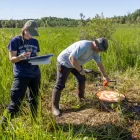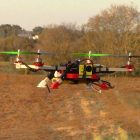Wildlife
Researchers use drones to find elusive Michigan rattlesnake
|
By Ruth Thornton
Standing together at Pierce Cedar Creek Institute near Hastings, Michigan, two students stared intently at the screen, looking for the subtle signs of the small rattlesnake they were trying to find. The eastern massasauga, Michigan’s only rattlesnake, typically hides in dense vegetation in wetlands, and conservation biologists are concerned about trampling their sensitive wetland habitats to study them. To avoid that problem, researchers are using drones equipped with heat-sensitive cameras to find them. “What I’m looking for is anything that looks what we call ‘snakey,’” said Brody Glei, a student at Grand Valley State University, as he looks at the screen with the camera feed – “where it’s either kind of looking like an S-curve or if it’s in some weird shape that doesn’t really look like vegetation.”
Those studying the rare and elusive eastern massasauga rattlesnake are hampered by its secretive behavior. Massasaugas hide so well that researchers often walk by just inches away without seeing them, Glei said.





